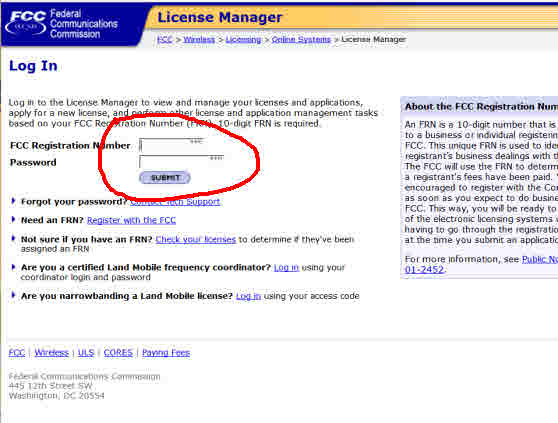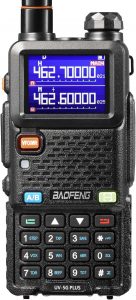Introduction
Many amateur radio operators started using GMRS (General Mobile Radio Service) before they became hams. It’s easy to get started in GMRS as it doesn’t require any testing. Simply pay the $35 license fee and you’ll have a GMRS license good for 10 years!
Below you’ll find information on how you too can get your GMRS license. If you’re already an amateur radio operator, it’s even easier as you already have your FRN number and simply have to put in a request for the ZA – General Mobile Radio Service license and pay the fee.
What is GMRS?
GMRS stands for General Mobile Radio Service. It is a licensed radio service that operates on channels around 462 MHz and 467 MHz. Here are some key points about GMRS:
- GMRS requires a license. That one license covers the licensee and their immediate family
- It uses the UHF 462/467MHz band for quality voice communications.
- Is a more powerful service for individuals than FRS.
- Handheld radios can be up to 5 watts but must transmit in analog.
- Repeaters are allowed with some limitations.
- You must be 18 years or older to apply for the license, but anyone within your family (regardless of age) can use the radios.
- Equipment must be certified for GMRS use.
- You can only transmit on frequencies designated for GMRS
So, how do you get a GMRS license?
First, you need to get your FRN number from the FCC. The FCC Registration Number (FRN) is a 10-digit unique identifying number that is assigned to entities doing business with the Commission. It is free to apply and get your FRN number. It is very easy to do by following these steps.
- To get your FRN, go to the FCC Universal Licensing System .
- Select “Register” on the ULS Home page, complete the online questionnaire.
- You will receive your FRN immediately upon completing the one-page online form.
Once you have your FRN number, you will need to log into your new account with the FCC and request your license. Here are the steps for doing that:
Follow the screen pages below. Answer the questions on the following screens to complete your GMRS license application. Navigate through each screen by clicking on the ‘Continue’ button. A printed copy of you new license will be mailed to you.
1. After obtaining your FRN select “Log In”

2. Login using your FRN and password.
You can access the login page page here: https://wireless2.fcc.gov/UlsEntry/licManager/login.jsp

3. Select “Apply For a New License” on the upper left-hand side of the screen.

4. Select “ZA – General Mobile Radio (GMRS)” from the drop-downmenu.
.jpg)
5. Complete your application by filling out the information.
6. Continue to the certification section, and certify your information is correct.
7. What to do after applying.
- Once you have completed the application wait 24 to 48 hours. Then using your FRN, log back into the FCC USL website to print a copy of your license. The FCC no longer mails copies.
So, after you get your GMRS license, what frequencies can you operate on?
The list of the GMRS frequencies available for use now that you have your license are:
| GMRS Simplex Channels and Frequencies | |||
|---|---|---|---|
| Channel | Frequency | Max Power | Bandwidth |
| 1 | 462.5625 | 5W | 25kHz* |
| 2 | 462.5875 | 5W | 25kHz* |
| 3 | 462.6125 | 5W | 25kHz* |
| 4 | 462.6375 | 5W | 25kHz* |
| 5 | 462.6625 | 5W | 25kHz* |
| 6 | 462.6875 | 5W | 25kHz* |
| 7 | 462.7125 | 5W | 25kHz* |
| 8 | 467.5625 | 0.5W | 12.5kHz |
| 9 | 467.5875 | 0.5W | 12.5kHz |
| 10 | 467.6125 | 0.5W | 12.5kHz |
| 11 | 467.6375 | 0.5W | 12.5kHz |
| 12 | 467.6625 | 0.5W | 12.5kHz |
| 13 | 467.6875 | 0.5W | 12.5kHz |
| 14 | 467.7125 | 0.5W | 12.5kHz |
| 15 | 462.5500 | 50W | 25kHz* |
| 16 | 462.5750 | 50W | 25kHz* |
| 17 | 462.6000 | 50W | 25kHz* |
| 18 | 462.6250 | 50W | 25kHz* |
| 19 | 462.6500 | 50W | 25kHz* |
| 20 | 462.6750 | 50W | 25kHz* |
| 21 | 462.7000 | 50W | 25kHz* |
| 22 | 462.7250 | 50W | 25kHz* |
| GMRS Repeater Channels and Frequencies | ||||
|---|---|---|---|---|
| Channel | RX Frequency | TX Frequency | Max Power | Bandwidth |
| RPT15 | 462.5500 | 467.5500 | 50W | 25kHz* |
| RPT16 | 462.5750 | 467.5750 | 50W | 25kHz* |
| RPT17 | 462.6000 | 467.6000 | 50W | 25kHz* |
| RPT18 | 462.6250 | 467.6250 | 50W | 25kHz* |
| RPT19 | 462.6500 | 467.6500 | 50W | 25kHz* |
| RPT20 | 462.6750 | 467.6750 | 50W | 25kHz* |
| PRT21 | 462.7000 | 467.7000 | 50W | 25kHz* |
| RPT22 | 462.7250 | 467.7250 | 50W | 25kHz* |
*Note: 20kHz Authorized Bandwidth.
Ok, so that list of frequencies is nice, but where locally can I get on a repeater and chat with others near me in the Hillsborough or Polk County areas?
Well, some nearby repeaters you will find some activity on are:
Polk CERT repeater (located in Bartow) on 462.725 (tone 141.3)
Lakeland repeater (located in downtown Lakeland) on 462.675 (tone 141.3)
Tampa on 462.575 (tone 141.3)
Tampa on 462.600 (tone 131.8)
Sebring on 462.675 (tone 100.0)
Is there a place I can find other repeaters near me?
Yes, there is. Click here to visit the https://mygmrs.com Web site to find other GMRS repeaters and resources.
Are you interested in assisting with emergency communications, or perhaps learning more about CERT (Community Emergency Response Teams)?
If you’re interested in assisting those in your community when disaster strikes, you should tune into a net that is now being held on the POLK CERT GMRS repeater (462.725).
Starting Tuesday March 5, 2024 at 7PM our inaugural GMRS net. You say why is this important. Several folks that are active hams today,came from and are still active in that operating mode. We also have community teams in many of our neighborhoods utilizing GMRS during drills and emergency. We have a station in the EOC that will be manned by dual license operators. So it’s good practice to have our GMRS operators proficient in formal notifications into the EOC. If you are dual lic, please join us on this March 5 net and welcome those folks. More information to come. 462.725/+ CTCSS 141.3 (a valid GMRS license is required)
Oh, this is fine and dandy, but I need a radio?
Well , now that you have your GMRS license and know where you can talk, you need a radio! If you’re just getting started, a low cost yet still powerful radio would be the Baofeng UV-5G Plus. You can find a link to this radio by clicking here .
This radio has some upgraded features such as USB-C charging (the same as your cell phone), as well as a 2500 mAh battery, scanning capabilities, NOAA weather radio reception, 5 watts output, a larger 1.5″ color display, and seamless frequency copy.
Here is a photo of the Baofeng UV-5G Plus.

